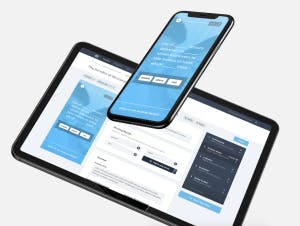Why you don’t need to be a designer to be a good teacher with EdApp

Good news for teachers who…
- have lots of low-tech teaching experience but are not all that high-tech savvy.
- are used to the physical classroom but feel strange in the virtual one.
- work hard on their lessons but don’t have weeks to spend on course development.
With EdApp rapid authoring, you don’t have to be high-tech savvy, spend weeks on course development, or even be a designer to produce professional, quality lessons, and feel comfortable in the virtual classroom.
What is rapid authoring?
Basically, a rapid SCORM authoring tool is an app (software) that supports fast and easy creation of professional courses. Rapid authoring makes use of technology to offer a variety of standardized templates which fit the needs of educators. Simply put, teachers can “plug in” their content as needed, save their template, and…done. Ready to teach in hours, not weeks.
Your rapid authored content travels with you.
Reliable rapid authoring tools such as EdApp are cloud-based, so they are wherever and whenever you are online. You don’t have to worry about having enough storage space, forgetting your USB (disk on key/memory stick), or perhaps even bringing your own computer. Your lessons are available on any online device, including iPhones and Android models.
Yes, rapid authoring does microlessons, too.
Rapid authoring follows industry best practices. That includes microlearning. As you may already know, presenting content to students in bite-sized chunks of up to 10-15 minutes facilitates learning and increases retention.
How does rapid authoring work?
It really is as easy as 1-2-3.
Step 1: Sign up to EdApp.
Signup takes seconds, and you’re ready to begin.
Step 2: Choose your template.
The EdApp template library is extensive. EdApp currently has 50 “plug in and go” formats designed from educator feedback. So, these templates support what teachers really need in the field. They not based on some “ivory tower” pedagogical theory.
To make your selection process even quicker, EdApp has grouped these templates into the following categories:
- Content: best suited for knowledge and first-time information.
- Concepts: reinforce bite-sized concepts on the word or sentence level.
- Multiple Choice Templates: varying formats including chat (to simulate real-life conversations) and animations (for powerful visual engagement).
- Numbers: number pickers, dialling up/down, and pie charts provide numerical reinforcement.
- Relationships: engagement through connections – matching, categorizing, ordering.
- Games: fun AND learning – unbeatable!
- Surveys: keep your lessons relevant and enjoyable via feedback from your learners.
- Advanced: specialized formats such as AICC, SCORM, External URL, and Question Pool.
Step 3: Create your content.
Complete your template(s) as needed. For example, copy/paste text to build Content Templates. Use a Relationships Template to match equipment images with descriptions for medical students or product salespeople. Drill information with a Jeopardy-style Quiz Game. Check “How am I doing?” by offering your learners a 3-5 answer option Survey.
Your course comes together like a train.
The train begins with its engine, the main power, which pulls all the cars behind it. In EdApp rapid authoring, this could be a Content Template module or perhaps something in the Concepts Template section.
Then, learners practice. String a variety of additional modules one after the other. Each module will have a slightly different focus or purpose. Combined together, they make up your “course train”.
End with a caboose—Perhaps a game to show your learners their progress in an exciting way. Maybe a survey to keep things on track. (Couldn’t resist!)

Device responsiveness is our responsibility.
You create the course. We figure out how to present it to your learners.
No matter whether they are on phones, pads, desktops, laptops, etc., EdApp’s rapid authoring templates adapt. Your lessons are always beautifully-designed and interactive as needed.
You’ll be able to make sure of that for yourself with our Preview feature.
Don’t forget content responsiveness, too!
Course content changes. New words are created and need to be learned. Products change or are invented. Procedures are revised to be safer and more efficient. For all these reasons and more, rapid authoring is built for simple updating.
And since it is so quick, teachers can offer more individualized learning. With just a few tweaks, it will be relatively easy to provide several levels of learning for different levels of students. This can include a few extra microlessons for those who could use more practice.
Here’s your “no designers needed, just good teachers” link to the world of rapid authoring.
You might also be interested in 20 free tech tools for teachers, or this list of free test maker.
Sources
https://www.edapp.com/rapid-authoring/template-library/relationships
https://www.edapp.com/authoring-tool/
https://www.edapp.com/blog/rapid-content-development
https://www.edapp.com/blog/rapid-authoring/
https://www.edapp.com/microlearning/
https://www.td.org/newsletters/learning-circuits/time-to-develop-one-hour-of-training-2009
Author
